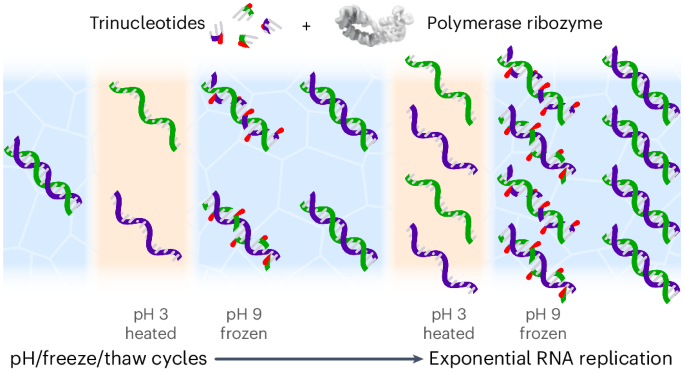2025-05-23 ユニバーシティ・カレッジ・ロンドン(UCL)
<関連情報>
- https://www.ucl.ac.uk/news/2025/may/ancient-dna-used-map-evolution-fever-causing-bacteria
- https://www.science.org/doi/10.1126/science.adr2147
古代のボレリアゲノムがシラミ媒介性再燃熱の進化の歴史を記録する Ancient Borrelia genomes document the evolutionary history of louse-borne relapsing fever
Pooja Swali, Thomas Booth, Cedric C. S. Tan, Jesse McCabe, […] , and Pontus Skoglund
Science Published:22 May 2025
DOI:https://doi.org/10.1126/science.adr2147
Editor’s summary
Louse-borne relapsing fever is caused by the bacterium Borrelia recurrentis, which is transmitted by body lice and is difficult to culture. Its unusually small genome has been the subject of speculation, with debates around when and why gene loss occurred. Swali et al. sequenced four ancient B. recurrentis genomes from remains in the UK, the oldest of which dates to 2300 to 2100 years ago. Many of the features of modern genomes were already displayed in these ancient samples, suggesting that the distinctive genomic changes in this species may have occurred only about 5000 years after divergence from its closest relative. —Corinne Simonti
Structured Abstract
INTRODUCTION
Three well-studied bacteria are transmitted by the human body louse, including the agent of trench fever Bartonella quintana, the epidemic typhus agent Rickettsia prowazekii, and the agent of louse-borne relapsing fever Borrelia recurrentis. These bacterial species are characterized by having ancestors with tick-borne hosts and exhibit higher virulence and lethality than their relatives. However, this evolutionary process of changing transmission dynamics, vector specialization, and virulence remains poorly understood.
RATIONALE
To study the origins and evolutionary history of louse-borne bacteria, we screened a large set of ancient DNA samples and identified four individuals from ancient Britain who harbored B. recurrentis infections. We sequenced these further using a whole-genome shotgun approach and obtained sufficient data to reconstruct the relatedness of ancient and contemporary strains and facilitate the analysis of pan-genome evolution. We inferred a chronology of the divergence of B. recurrentis from its tick-borne ancestor using the radiocarbon dates of the specimens and reconstructed pan-genome evolution given the available genomic variation in the Borrelia genus.
RESULTS
By coupling variation in sampling time and genomic variation in the different genomes, we inferred a mutation rate that allowed us to estimate the divergence of B. recurrentis from its closest tick-borne relative, Borrelia duttonii Ly, to ~6000 to ~4000 years ago. This emergence time frame coincides with human lifestyle changes in the Neolithic and Bronze Ages, including the advent of wool-based textiles. We reconstructed a temporal pan-genome and show that gene turnover can be reconstructed to have occurred directly in our sampled time series between ~2000 and ~1000 years ago, particularly in genes today that are implicated in plasmid partitioning.
CONCLUSION
Our results suggest that human cultural changes, such as the adoption of wool-based or other clothing, can influence the emergence and diversification of new pathogens. We show that genome reduction in B. recurrentis was a complex evolutionary process that can be directly observed to have continued between ~2000 and ~800 years ago. Our work demonstrates the potential of whole-genome pan-genome analysis of ancient pathogen DNA.
OPEN IN VIEWER
Inferred events in the emergence of louse-borne relapsing fever.
We sequenced B. recurrentis genomes from Iron Age and medieval Britain and reconstructed core and accessory gene diversity using present-day genomes. We estimate a divergence from known tick-borne lineages to ~6000 to ~4000 years ago, a period coinciding with sedentism, domestication, and the advent of wool-based clothing and trade. We document gene gains (red) and losses (yellow) between Iron Age and medieval genomes, demonstrating ongoing complex evolution. kya, thousand years ago.
Abstract
Several bacterial pathogens have transitioned from tick-borne to louse-borne transmission, which often involves genome reduction and increasing virulence. However, the timing of such transitions remains unclear. We sequenced four ancient Borrelia recurrentis genomes, the agent of louse-borne relapsing fever, dating from 2300 to 600 years ago. We estimated the divergence from its closest tick-borne relative to 6000 to 4000 years ago, which suggests an emergence coinciding with human lifestyle changes such as the advent of wool-based textiles. Pan-genome analysis indicated that much of the evolution characteristic of B. recurrentis had occurred by ~2300 years ago, though further gene turnover, particularly in plasmid partitioning, persisted until ~1000 years ago. Our findings provide a direct genomic chronology of the evolution of this specialized vector-borne pathogen.


